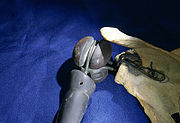
Jules-Émile Péan
Encyclopedia


France
The French Republic , The French Republic , The French Republic , (commonly known as France , is a unitary semi-presidential republic in Western Europe with several overseas territories and islands located on other continents and in the Indian, Pacific, and Atlantic oceans. Metropolitan France...
surgeons of the 19th century.
Péan was born in 1830 in Marboué, four kilometers to the north of Châteaudun
Châteaudun
Châteaudun is a commune in the Eure-et-Loir department in northern France. It is a sub-prefecture of Eure-et-Loir.-Geography:Châteaudun is located about 45 km northwest of Orléans, and about 50 km south-southwest of Chartres, on the river Loir, a tributary of the...
, the son of a miller. He studied at the college of Chartres
Chartres
Chartres is a commune and capital of the Eure-et-Loir department in northern France. It is located southwest of Paris.-Geography:Chartres is built on the left bank of the Eure River, on a hill crowned by its famous cathedral, the spires of which are a landmark in the surrounding country...
and then studied medicine in Paris
Paris
Paris is the capital and largest city in France, situated on the river Seine, in northern France, at the heart of the Île-de-France region...
under Auguste Nélaton
Auguste Nélaton
Auguste Nélaton was a French physician and surgeon. Born at Paris, he began studying medicine in 1828 and was graduated as an M.D. in 1836 with a thesis on the effects of tuberculosis on the bones. Three years later, he became a professor at the Hôpital St. Louis with a habilitation on breast tumors...
. He was appointed a doctor in 1861 and worked at St Antoine and St Louis up to 1893. He then created with its expenses the international hospital. He wrote two volumes of private clinics (1876 and 1890). He entered with the academy of medicine on November 22, 1887. He was awarded Commander of Legion of Honor
Légion d'honneur
The Legion of Honour, or in full the National Order of the Legion of Honour is a French order established by Napoleon Bonaparte, First Consul of the Consulat which succeeded to the First Republic, on 19 May 1802...
in 1893. He died on January 20, 1898 in Paris
Paris
Paris is the capital and largest city in France, situated on the river Seine, in northern France, at the heart of the Île-de-France region...
. A street, Rue Péan, in Châteaudun was named after him.
Péan was very admired but controversial in his time: although a follower of hygiene, he disputed the discoveries of Louis Pasteur
Louis Pasteur
Louis Pasteur was a French chemist and microbiologist born in Dole. He is remembered for his remarkable breakthroughs in the causes and preventions of diseases. His discoveries reduced mortality from puerperal fever, and he created the first vaccine for rabies and anthrax. His experiments...
. He refused to dissect corpses and operated preferably in residence. Although a teacher, he was never named professor. He was the first to make a successful surgical ablation of one cyst of the ovary in 1864. He was also a pioneer in performing a vaginal hysterectomy
Hysterectomy
A hysterectomy is the surgical removal of the uterus, usually performed by a gynecologist. Hysterectomy may be total or partial...
for carcinoma
Carcinoma
Carcinoma is the medical term for the most common type of cancer occurring in humans. Put simply, a carcinoma is a cancer that begins in a tissue that lines the inner or outer surfaces of the body, and that generally arises from cells originating in the endodermal or ectodermal germ layer during...
in 1890. He is believed to have performed the first surgery to correct diverticula of the bladder in 1895. In 1893, he attempted the first known total joint arthroplasty
Arthroplasty
Arthroplasty is an operative procedure of orthopedic surgery performed, in which the arthritic or dysfunctional joint surface is replaced with something better or by remodeling or realigning the joint by osteotomy or some other procedure.-Background:Previously, a popular form of arthroplasty was...
, implanted in the shoulder of a French waiter in 1893; it had to be removed two years later due to infection. He invented a hemostat
Hemostat
A hemostat , is a vital surgical tool used in almost any surgical procedure, usually to control bleeding. Therefore, it is not uncommon to see the initial incision lined with hemostats closing blood vessels awaiting ligation during the initial phases of surgery...
that still used in operating rooms around the world.

